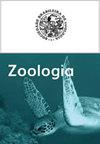Three new species of Urocleidoides (Monogenoidea: Dactylogyridae) parasitizing characiforms (Actinopterygii: Characiformes) in Tocantins River, states of Tocantins and Maranhão, and new record for U. triangulus in Guandu River, state of Rio de Janeiro, Brazil
IF 1.8
4区 生物学
Q4 ZOOLOGY
引用次数: 4
Abstract
Three new species of Urocleidoides Mizelle & Price, 1964 are described from the gills of characiform fishes in the Tocantins River and its tributaries. Urocleidoides boulengerellae sp. nov. is described from Boulengerella cuvieri (Spix & Agassiz, 1829) and differs from all its congeners by the dorsal bar with a long posteromedial projection; male copulatory organ with 2–3 counterclockwise rings and a base with a flange; an accessory piece comprising a robust Y-shaped unit and a sheath-like unit; and a highly sclerotized vaginal canal. Urocleidoides paratriangulus sp. nov., described from Psectrogaster amazonica Eigenmann & Eigenmann, 1889, Cyphocharax gouldingi Vari, 1992, Caenotropus labyrinthicus (Kner, 1858) and Mylesinus paucisquamatus Jégu & Santos, 1988, is most similar to Urocleidoides triangulus (Suriano, 1981) Rossin & Timi, 2016 based on the shape of the anchors and bars but differs from U. triangulus in the morphology of the projection of the dorsal bar, the number of rings of male copulatory organ, and by the smaller size of members of hook pairs 1 and 5 compared with those of the remaining pairs. Urocleidoides tocantinensis sp. nov. is easily distinguished from all other species of the genus by the morphology of the vagina, which present a vaginal vestibule with a membranous cap. Urocleidoides triangulus is reported from its type host in the Guandu River, state of Rio de Janeiro. The present study increases the number of Urocleidoides species to 37 recognized species that fit all the generic characters.巴西里约热内卢州Tocantins河和maranh河三种寄生特征虫(放线虫科:特征虫)和官渡河三种新记录
从托坎汀斯河及其支流的特征鱼类的鳃中描述了三种新物种。boulengerellae sp. 11 .是由Boulengerella cuvieri (Spix & Agassiz, 1829)描述的,它与所有同系物的不同之处是其背条具有较长的后内侧突起;雄性交配器官具2-3个逆时针的环和一具凸缘的基部;附件件,包括坚固的y形单元和鞘状单元;以及高度硬化的阴道。根据锚和杆的形状,从Psectrogaster amazonica Eigenmann & Eigenmann, 1889年,Cyphocharax gouldingi Vari, 1992年,Caenotropus迷宫(Kner, 1858年)和Mylesinus paucisquamatus j & Santos, 1988年描述的Urocleidoides partriangulus (Suriano, 1981年)和Rossin & Timi, 2016年与U. triangulus最相似,但在背杆的突出形态,雄性交配器官的环数,1号和5号鱼钩的成员比其他鱼钩的成员要小。根据阴道的形态,可以很容易地将其与所有其他种类区分开来,阴道有一个带膜状帽的阴道前庭。三角尾线蛛在巴西里约热内卢州官渡河的类型寄主中有报道。本研究将尿线纲的种类增加到37种,符合所有的属特征。
本文章由计算机程序翻译,如有差异,请以英文原文为准。
求助全文
约1分钟内获得全文
求助全文
来源期刊

Zoologia
生物-动物学
自引率
0.00%
发文量
15
期刊介绍:
Zoologia, the scientific journal of the Sociedade Brasileira de Zoologia (SBZ), is an international peer-reviewed, open-access Zoological journal that publishes original research on systematics, evolution, taxonomy, nomenclature, biogeography, morphology, physiology, biology, ecology, symbiosis, conservation, behavior, genetics and allied fields. The journal, formerly known as Revista Brasileira de Zoologia, publishes original articles authored by both members and non-members of the Society. The manuscripts should be written exclusively in English.
 求助内容:
求助内容: 应助结果提醒方式:
应助结果提醒方式:


